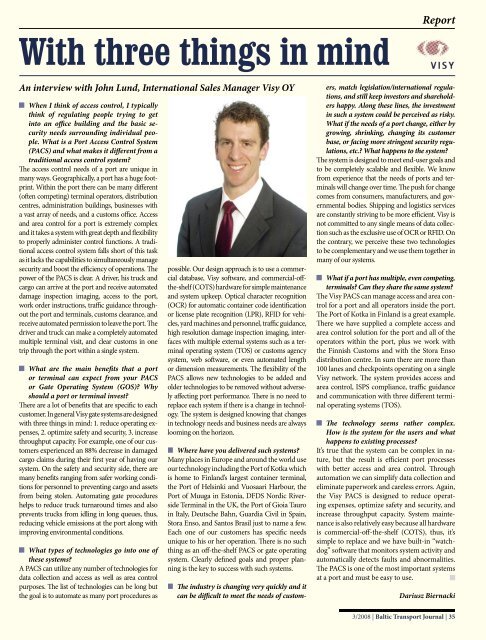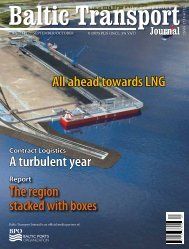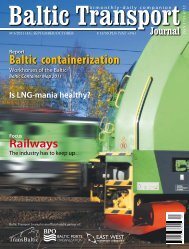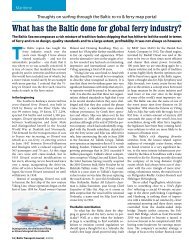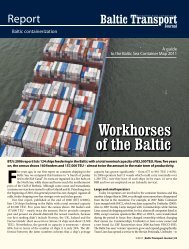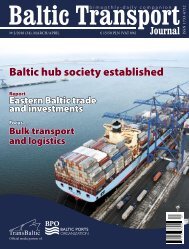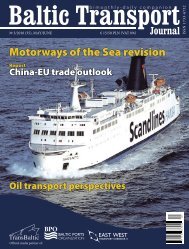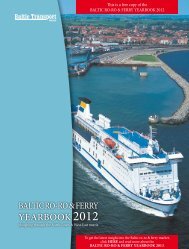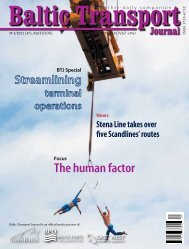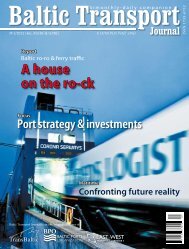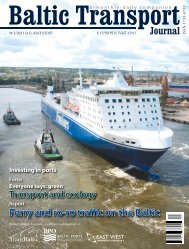Create successful ePaper yourself
Turn your PDF publications into a flip-book with our unique Google optimized e-Paper software.
With three things in mind<br />
An interview with John Lund, International Sales Manager Visy OY<br />
When I think of access control, I typically<br />
think of regulating people trying to get<br />
into an office building and the basic security<br />
needs surrounding individual people.<br />
What is a Port Access Control System<br />
(PACS) and what makes it different from a<br />
traditional access control system?<br />
The access control needs of a port are unique in<br />
many ways. Geographically, a port has a huge footprint.<br />
Within the port there can be many different<br />
(often competing) terminal operators, distribution<br />
centres, administration buildings, businesses with<br />
a vast array of needs, and a customs office. Access<br />
and area control for a port is extremely complex<br />
and it takes a system with great depth and flexibility<br />
to properly administer control functions. A traditional<br />
access control system falls short of this task<br />
as it lacks the capabilities to simultaneously manage<br />
security and boost the efficiency of operations. The<br />
power of the PACS is clear. A driver, his truck and<br />
cargo can arrive at the port and receive automated<br />
damage inspection imaging, access to the port,<br />
work order instructions, traffic guidance throughout<br />
the port and terminals, customs clearance, and<br />
receive automated permission to leave the port. The<br />
driver and truck can make a completely automated<br />
multiple terminal visit, and clear customs in one<br />
trip through the port within a single system.<br />
What are the main benefits that a port<br />
or terminal can expect from your PACS<br />
or Gate Operating System (GOS)? Why<br />
should a port or terminal invest?<br />
There are a lot of benefits that are specific to each<br />
customer. In general Visy gate systems are designed<br />
with three things in mind: 1. reduce operating expenses,<br />
2. optimize safety and security, 3. increase<br />
throughput capacity. For example, one of our customers<br />
experienced an 88% decrease in damaged<br />
cargo claims during their first year of having our<br />
system. On the safety and security side, there are<br />
many benefits ranging from safer working conditions<br />
for personnel to preventing cargo and assets<br />
from being stolen. Automating gate procedures<br />
helps to reduce truck turnaround times and also<br />
prevents trucks from idling in long queues, thus,<br />
reducing vehicle emissions at the port along with<br />
improving environmental conditions.<br />
What types of technologies go into one of<br />
these systems?<br />
A PACS can utilize any number of technologies for<br />
data collection and access as well as area control<br />
purposes. The list of technologies can be long but<br />
the goal is to automate as many port procedures as<br />
possible. Our design approach is to use a commercial<br />
database, Visy software, and commercial-offthe-shelf<br />
(COTS) hardware for simple maintenance<br />
and system upkeep. Optical character recognition<br />
(OCR) for automatic container code identification<br />
or license plate recognition (LPR), RFID for vehicles,<br />
yard machines and personnel, traffic guidance,<br />
high resolution damage inspection imaging, interfaces<br />
with multiple external systems such as a terminal<br />
operating system (TOS) or customs agency<br />
system, web software, or even automated length<br />
or dimension measurements. The flexibility of the<br />
PACS allows new technologies to be added and<br />
older technologies to be removed without adversely<br />
affecting port performance. There is no need to<br />
replace each system if there is a change in technology.<br />
The system is designed knowing that changes<br />
in technology needs and business needs are always<br />
looming on the horizon.<br />
Where have you delivered such systems?<br />
Many places in Europe and around the world use<br />
our technology including the Port of Kotka which<br />
is home to Finland’s largest container terminal,<br />
the Port of Helsinki and Vuosaari Harbour, the<br />
Port of Muuga in Estonia, DFDS Nordic Riverside<br />
Terminal in the UK, the Port of Gioia Tauro<br />
in Italy, Deutsche Bahn, Guardia Civil in Spain,<br />
Stora Enso, and Santos Brasil just to name a few.<br />
Each one of our customers has specific needs<br />
unique to his or her operation. There is no such<br />
thing as an off-the-shelf PACS or gate operating<br />
system. Clearly defined goals and proper planning<br />
is the key to success with such systems.<br />
The industry is changing very quickly and it<br />
can be difficult to meet the needs of custom-<br />
Report<br />
ers, match legislation/international regulations,<br />
and still keep investors and shareholders<br />
happy. Along these lines, the investment<br />
in such a system could be perceived as risky.<br />
What if the needs of a port change, either by<br />
growing, shrinking, changing its customer<br />
base, or facing more stringent security regulations,<br />
etc.? What happens to the system?<br />
The system is designed to meet end-user goals and<br />
to be completely scalable and flexible. We know<br />
from experience that the needs of ports and terminals<br />
will change over time. The push for change<br />
comes from consumers, manufacturers, and governmental<br />
bodies. Shipping and logistics services<br />
are constantly striving to be more efficient. Visy is<br />
not committed to any single means of data collection<br />
such as the exclusive use of OCR or RFID. On<br />
the contrary, we perceive these two technologies<br />
to be complementary and we use them together in<br />
many of our systems.<br />
What if a port has multiple, even competing,<br />
terminals? Can they share the same system?<br />
The Visy PACS can manage access and area control<br />
for a port and all operators inside the port.<br />
The Port of Kotka in Finland is a great example.<br />
There we have supplied a complete access and<br />
area control solution for the port and all of the<br />
operators within the port, plus we work with<br />
the Finnish Customs and with the Stora Enso<br />
distribution centre. In sum there are more than<br />
100 lanes and checkpoints operating on a single<br />
Visy network. The system provides access and<br />
area control, ISPS compliance, traffic guidance<br />
and communication with three different terminal<br />
operating systems (TOS).<br />
The technology seems rather complex.<br />
How is the system for the users and what<br />
happens to existing processes?<br />
It’s true that the system can be complex in nature,<br />
but the result is efficient port processes<br />
with better access and area control. Through<br />
automation we can simplify data collection and<br />
eliminate paperwork and careless errors. Again,<br />
the Visy PACS is designed to reduce operating<br />
expenses, optimize safety and security, and<br />
increase throughput capacity. System maintenance<br />
is also relatively easy because all hardware<br />
is commercial-off-the-shelf (COTS), thus, it’s<br />
simple to replace and we have built-in “watchdog”<br />
software that monitors system activity and<br />
automatically detects faults and abnormalities.<br />
The PACS is one of the most important systems<br />
at a port and must be easy to use.<br />
Dariusz Biernacki<br />
3/<strong>2008</strong> | <strong>Baltic</strong> <strong>Transport</strong> <strong>Journal</strong> | 35


